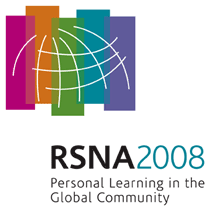
Abstract Archives of the RSNA, 2008
Matthew Byer Christensen BEng, Presenter: Nothing to Disclose
Perry J. Pickhardt MD, Abstract Co-Author: Consultant, Viatronix, Inc
Consultant, Medicsight, Inc
Consultant, C.B. Fleet Company, Inc
Consultant, Covidien AG
Brian Edward Nett BS, Abstract Co-Author: Nothing to Disclose
Jamey Paul Weichert PhD, Abstract Co-Author: President, Cellectar, LLC
Chairman, Cellectar, LLC
The purpose of this project is to demonstrate that adequate diagnosis in CT colonography (CTC) can be achieved with fewer projections than currently employed. Undersampling the number of projections without sacrificing imaging quality would reduce dose.
CTC DICOM images were loaded into MATLAB to be used as a digital phantom. MATLAB's fanbeam function was used to forward project the data using the geometry of a typical commercial scanner. The source to center as 541 mm, the number of detector elements was 813 and there were 1200 views. The resulting sinogram was decimated to form uniformly sampled projection datasets with undersampling factors of: 2, 4, 8, and 16. The missing data was then filled in using a linear interpolation technique and reconstructed using filtered backprojection. Root Mean Square Error and Signal-to-Noise of the reconstructed datasets were measured using the original as the reference. A gastrointestinal radiologist with expertise in CTC blindly reviewed the reconstructions as well as the original to compare diagnostic quality.
RMSE for the reconstructions decimated by a factor of 2, 4, 8, and 16 was 54.3, 124.9, 248.8, and 273, respectively. SNR was 27.3, 20, 14, and 13.2 dB, respectively. Initial qualitative image assessment by the radiologist demonstrated that acceptable image quality can be achieved at an undersampling factor of 4. There was minimal qualitative difference between the full projection reconstruction and those undersampled by a factor of 2 or 4. A factor of 8 yielded an image below diagnostic level.
Further improvements in image quality are expected when more sophisticated image reconstruction is utilized. Diagnostic quality appears to be achievable even when the number of projections is reduced from 1200 to 300, with interpolation, corresponding to an undersampling factor of 4. These results support the notion that undersampling in CTC can reduce dose substantially without compromising clinical diagnosis. Further improvements in image quality are expected when more sophisticated image reconstruction is utilized.
This technique offers promise to substantially reduce the radiation dose delivered for CTC, which is vitally important for any screening examination.
Christensen, M,
Pickhardt, P,
Nett, B,
Weichert, J,
Undersampling Projections in CT Colonography to Lower Dose. Radiological Society of North America 2008 Scientific Assembly and Annual Meeting, February 18 - February 20, 2008 ,Chicago IL.
http://archive.rsna.org/2008/6010876.html

